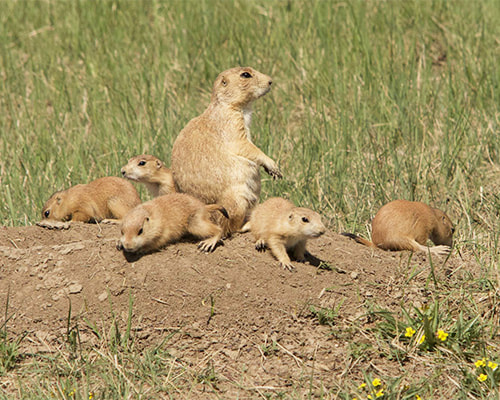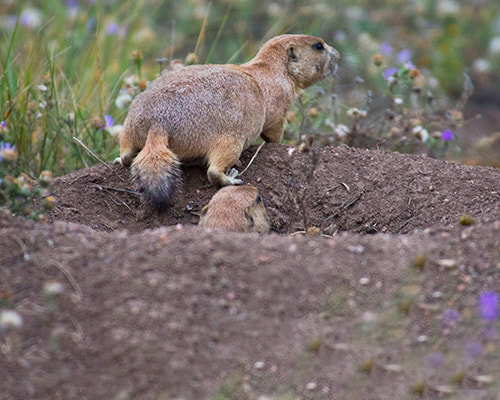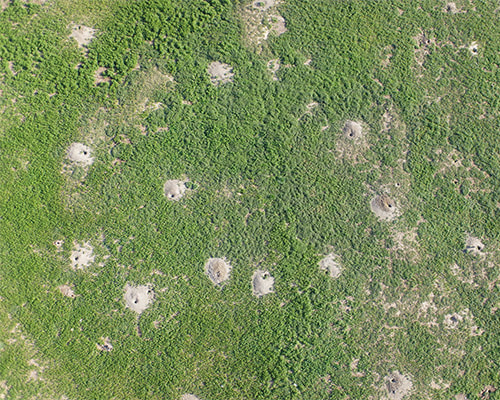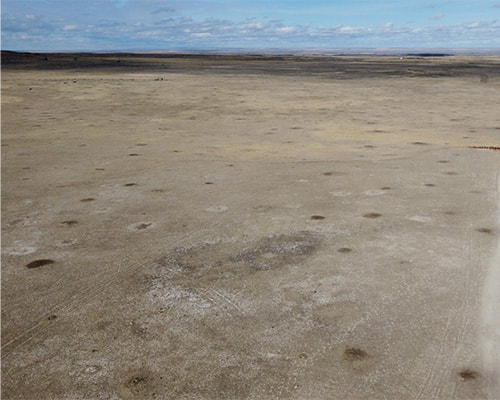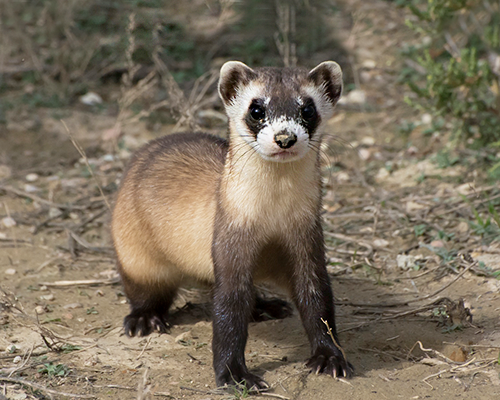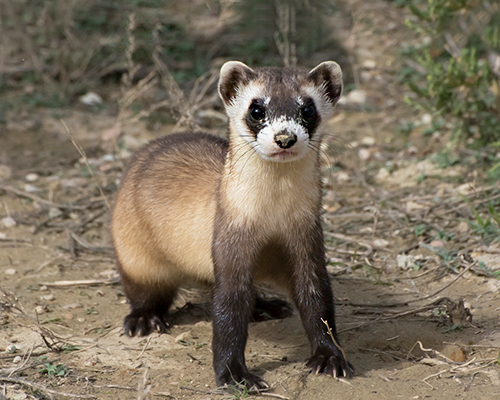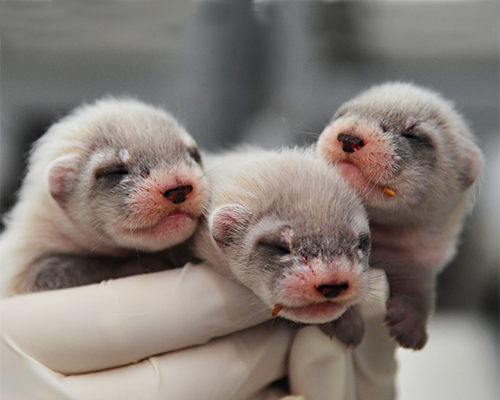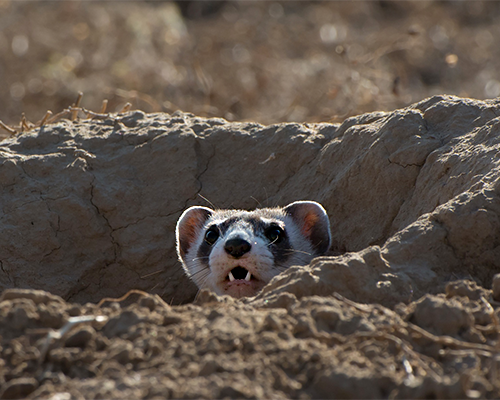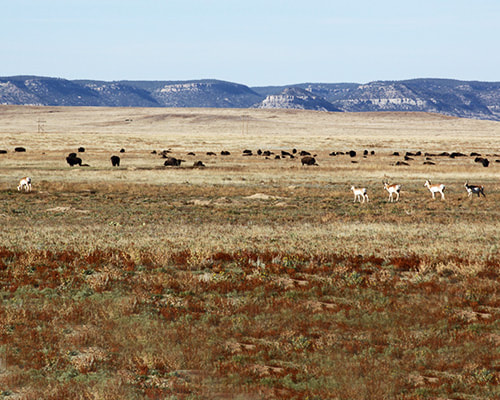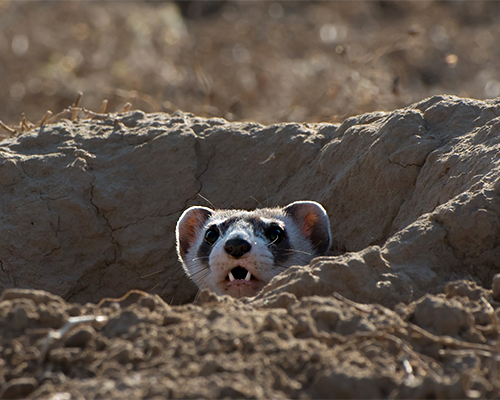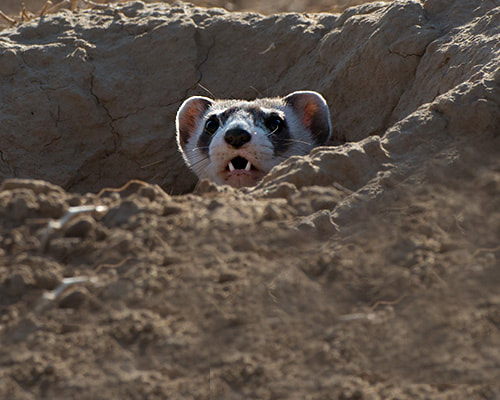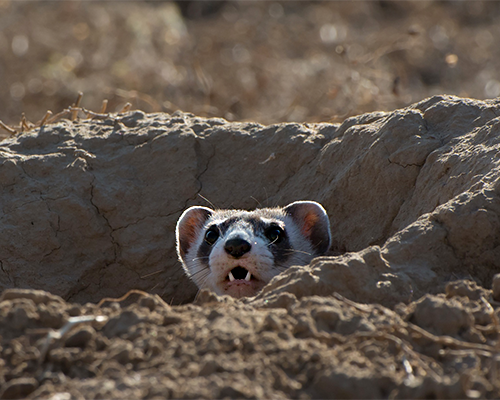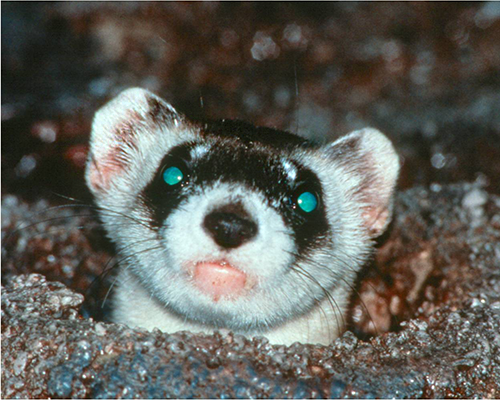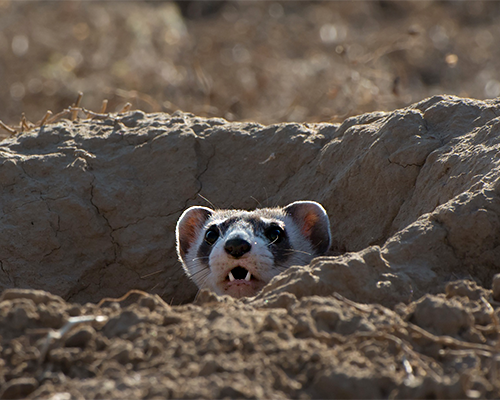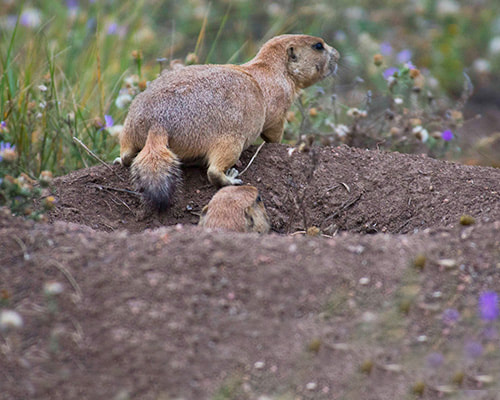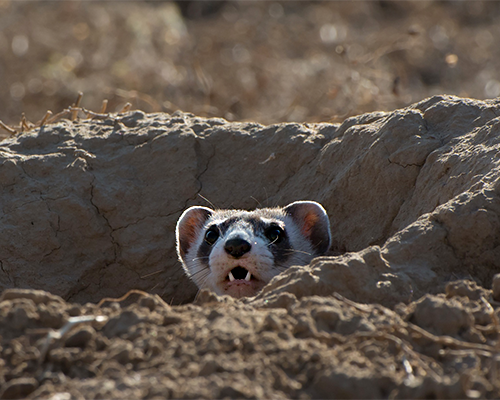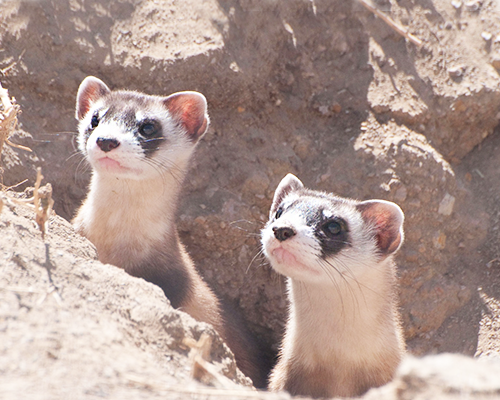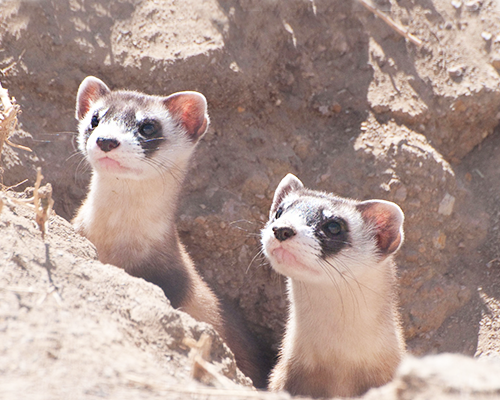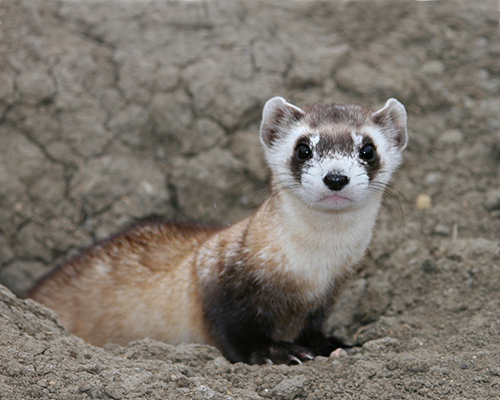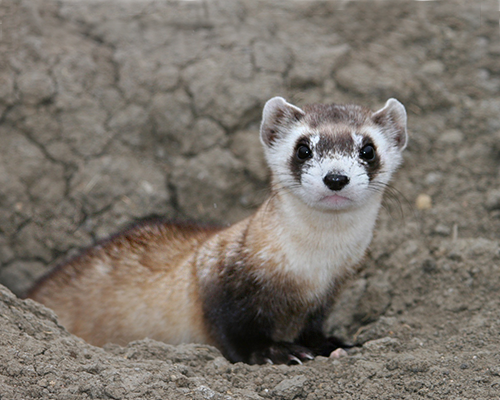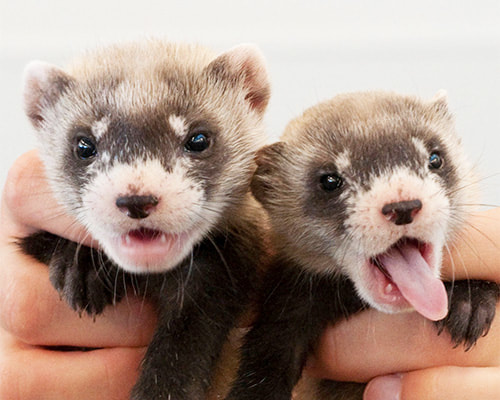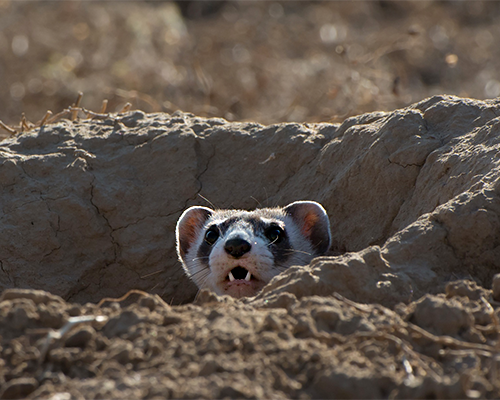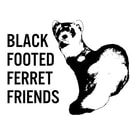|
Role of Prairie Dogs
The black-footed ferret is a specialist predator and obligate species of the prairie dog. Prairie dogs and the burrow systems they create are critical to black-footed ferrets as both a primary food source and for their ability to create and maintain habitat. This relationship links the recovery of the black-footed ferret to the management and conservation of prairie dogs throughout western North America. |
|
Prairie Dogs
Prairie dogs are members the ground squirrel family (Sciuridae) which are part of the rodent order. There are five species for prairie dogs, all of which reside on grassland ecosystems in North America including Gunnison's, white-tailed, black-tailed, Mexican, and Utah prairie dogs. Although these species look similar, each exhibits their own unique characteristics such as body size, behaviors, tail colors (in the case of white-tailed versus black-tailed) and distribution. Adult prairie dogs range in size from 1.5 to 3.0 pounds (0.5 to 1.36 kg) depending on species and sex. Prairie dogs can have 3-8 young per year called pups and can exist at densities of upwards of 50 individuals per acre. Prairie dogs are herbivores and eat various grasses, forbs, seeds, roots, and fruits found on the prairie. Some species of prairie dog hibernate during the winter months, but others remain active year round. Prairie dogs have many predators making them an important food source for species such as badgers, golden eagles, hawks, foxes, coyotes, and black-footed ferrets occurring on the prairie. |
Colonies and Burrows
An important characteristic of prairie dogs is their ability to create and maintain colonies and burrow systems in grassland ecosystems. A colony is defined as an area where prairie dogs occur together in relatively close proximity. Within these colonies, foraging behaviors by prairie dogs can trim the height of nearby vegetation and change the composition of plant species. These altered landscapes can provide bare ground for nesting birds such as mountain plovers and horned larks, and the altered plant composition is sometime preferred by grazing ungulates such as pronghorn, elk, and bison. The burrows that prairie dogs create within these colonies also provide vital habitat to a host of species. A prairie dog burrow can be 2-3 meters in depth and may occur at densities upwards of 80 aboveground burrow entrances per acre depending on species, population size, and environmental conditions. The underground burrows provides a source of shelter from predators and temperature regulation for species such as burrowing owls, cottontails, jackrabbits, various reptiles, swift fox, and black-footed ferrets. This ability to create habitat makes prairie dogs a keystone species and an important part of grassland ecosystems.
An important characteristic of prairie dogs is their ability to create and maintain colonies and burrow systems in grassland ecosystems. A colony is defined as an area where prairie dogs occur together in relatively close proximity. Within these colonies, foraging behaviors by prairie dogs can trim the height of nearby vegetation and change the composition of plant species. These altered landscapes can provide bare ground for nesting birds such as mountain plovers and horned larks, and the altered plant composition is sometime preferred by grazing ungulates such as pronghorn, elk, and bison. The burrows that prairie dogs create within these colonies also provide vital habitat to a host of species. A prairie dog burrow can be 2-3 meters in depth and may occur at densities upwards of 80 aboveground burrow entrances per acre depending on species, population size, and environmental conditions. The underground burrows provides a source of shelter from predators and temperature regulation for species such as burrowing owls, cottontails, jackrabbits, various reptiles, swift fox, and black-footed ferrets. This ability to create habitat makes prairie dogs a keystone species and an important part of grassland ecosystems.
Management
Healthy prairie dog colonies are therefore essential to the recovery of black-footed ferret populations. Wildlife managers regularly conduct efforts to monitor the status of prairie dog colonies. Monitoring techniques include mapping of colony boundaries, counting burrows, and estimating the population size of prairie dogs by counting the number of prairie dogs observed aboveground. These monitoring efforts are used to guide management actions primarily focused on improving habitat to promote prairie dog populations and mitigating diseases that impact prairie dogs such as Sylvatic plague. Habitat improvement projects can include vegetative treatments to remove certain vegetation types that impede the expansion of colonies, installation of artificial burrows to encourage prairie dogs to relocate to more desirable locations, or translocations of prairie dogs to increase connectivity between colonies. Disease management of plague typically occurs by treating burrows with the pesticide deltamethrin. This treatment helps to prevent plague outbreaks by reducing the number of fleas on the landscape. Fleas are the primary vector by which plague infects prairie dogs and is spread between prairie dogs.
Healthy prairie dog colonies are therefore essential to the recovery of black-footed ferret populations. Wildlife managers regularly conduct efforts to monitor the status of prairie dog colonies. Monitoring techniques include mapping of colony boundaries, counting burrows, and estimating the population size of prairie dogs by counting the number of prairie dogs observed aboveground. These monitoring efforts are used to guide management actions primarily focused on improving habitat to promote prairie dog populations and mitigating diseases that impact prairie dogs such as Sylvatic plague. Habitat improvement projects can include vegetative treatments to remove certain vegetation types that impede the expansion of colonies, installation of artificial burrows to encourage prairie dogs to relocate to more desirable locations, or translocations of prairie dogs to increase connectivity between colonies. Disease management of plague typically occurs by treating burrows with the pesticide deltamethrin. This treatment helps to prevent plague outbreaks by reducing the number of fleas on the landscape. Fleas are the primary vector by which plague infects prairie dogs and is spread between prairie dogs.
Conservation Challenges
Two of the greatest challenges to prairie dog conservation, and subsequently, black-footed ferret recovery, are plague and public tolerance. Although there are tools such as deltamethrin currently available to reduce the impact of plague, these are costly and labor intensive to implement and can lead to resistant flea populations. Efforts to develop and evaluate new tools for mitigating plague are currently ongoing. In addition, due to the burrow systems they create and their foraging behaviors, prairie dogs are sometimes viewed as an undesirable pest by a portion of the public. Prairie dogs are frequently lethally removed from areas where their colonies and burrows cause issues to agricultural, residential, or industrial endeavors.
As a result of these current challenges and historical eradication campaigns, prairie dog populations are estimated to be as low as 2% of what they were during the 1800s. Of the five species, the Mexican prairie dog is federally endangered, the Utah prairie dog is currently listed as federally threatened, and the white-tailed prairie dog has recently been petitioned for listing but found to be not warranted at this time.
Two of the greatest challenges to prairie dog conservation, and subsequently, black-footed ferret recovery, are plague and public tolerance. Although there are tools such as deltamethrin currently available to reduce the impact of plague, these are costly and labor intensive to implement and can lead to resistant flea populations. Efforts to develop and evaluate new tools for mitigating plague are currently ongoing. In addition, due to the burrow systems they create and their foraging behaviors, prairie dogs are sometimes viewed as an undesirable pest by a portion of the public. Prairie dogs are frequently lethally removed from areas where their colonies and burrows cause issues to agricultural, residential, or industrial endeavors.
As a result of these current challenges and historical eradication campaigns, prairie dog populations are estimated to be as low as 2% of what they were during the 1800s. Of the five species, the Mexican prairie dog is federally endangered, the Utah prairie dog is currently listed as federally threatened, and the white-tailed prairie dog has recently been petitioned for listing but found to be not warranted at this time.
